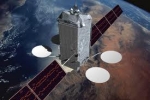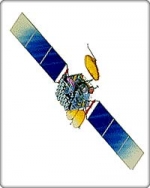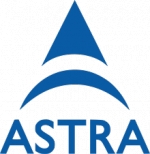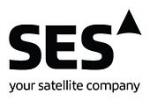Displaying items by tag: telecommunications
Iridium Communications Inc.
Iridium Communications Inc. is a company, based in McLean, Virginia, United States which operates the Iridium satellite constellation, a system of 66 active satellites used for worldwide voice and data communication from hand-heldsatellite phones and other transceiver units. The Iridium network is unique in that it covers the whole Earth, including poles, oceans and airways. The company derives its name from the chemical element iridium. The number of satellites projected in the early stages of planning was 77, the atomic number of iridium, evoking the metaphor of 77 electrons orbiting the nucleus.
Iridium satellite constellation
The Iridium satellite constellation is a large group of satellites providing voice and data coverage to satellite phones, pagers and integrated transceivers over Earth's entire surface. The company Iridium Communications Inc. owns and operates the constellation and sells equipment and access to its services.
The constellation operates 66 active satellites in orbit to complete its constellation and additional spare satellites are kept in-orbit to serve in case of failure. Satellites are in low Earth orbit at a height of approximately 485 mi (781 km) and inclination of 86.4°. Orbital velocity of the satellites is approximately 17,000 mph (27,000 km/h). Satellites communicate with neighboring satellites via Ka band inter-satellite links. Each satellite can have four inter-satellite links: two to neighbors fore and aft in the same orbital plane, and two to satellites in neighboring planes to either side. The satellites orbit from pole to pole with an orbit of roughly 100 minutes. This design means that there is excellent satellite visibility and service coverage at the North and South poles, where there are few customers. The over-the-pole orbital design produces "seams" where satellites in counter-rotating planes next to one another are traveling in opposite directions. Cross-seam inter-satellite link hand-offs would have to happen very rapidly and cope with large Doppler shifts; therefore, Iridium supports inter-satellite links only between satellites orbiting in the same direction.
Boeing 702 satellite
The Boeing 702 satellite is a family of geostationnary satellites designed and manufactured by the company Boeing.
Its design requirements include lower cost and high reliability. It offers a broad spectrum of modularity. A primary example is payload/bus integration. After the payload is tailored to customer specifications, the payload module mounts to the common bus module at only four locations and with only six electrical connectors. This design simplicity confers advantages. First, nonrecurring program costs are reduced, because the bus does not need to be changed for every payload, and payloads can be freely tailored without affecting the bus. Second, the design permits faster parallel bus and payload processing. This leads to the third advantage: a short production schedule.
Further efficiency derives from the 702's advanced xenon ion propulsion system (XIPS), which was pioneered by Boeing. XIPS is 10 times more efficient than conventional liquid fuel systems. Four 25-cm thrusters provide economical stationkeeping, needing only 5 kg of fuel per year - a fraction of what bipropellant or arcjet systems consume. Using XIPS for final orbit insertion conserves more mass as compared to using an on-board liquid apogee engine. Customers can apply the weight savings to increase the revenue-generating payload, to prolong service life, or to change to a less expensive launch vehicle (when cost is based on satellite mass).
Boeing 601 satellite
The Boeing 601 satellite is a body-stabilized geostationary satellite.
The Boeing 601 was introduced in 1987 to meet anticipated requirements for high-power, multiple-payload satellites for such applications as direct television broadcasting to small receiving antennas, very small aperture terminals for private business networks, and mobile communications. The basic configuration features as many as 48 transponders and offers up to 4,800 watts.
A more powerful version, the Boeing 601HP, made its debut in 1995. The HP versions can carry payloads twice as powerful as the classic Boeing 601 models, through such innovations as gallium arsenide solar cells, advanced battery technology, and an optional xenon ion propulsion system. The 601HP features as many as 60 transponders and provides up to 10,000 watts.
All Boeing 601 spacecraft use the same basic bus design, enabling Boeing to realize efficiencies gained by production volume, tooling investments and quantity buys.
Astra (satellite)
Astra is the brand name for a number of geostationary communication satellites, both individually and as a group, which are owned and operated by SES S.A., a global satellite operator based in Betzdorf, in eastern Luxembourg. The name is also used to describe the pan-European broadcasting system provided by these satellites, the channels carried on them, and even the reception equipment.
SES - Société Européenne des Satellites
SES, Société Européenne des Satellites, is a global satellite owner and operator, founded in 1985, and based in Betzdorf, Luxembourg.
SES is the world’s second-largest telecommunications satellite operator by revenue and operates a fleet of 50 geostationary satellites able to reach 99% of the World’s population. These satellites provide satellite communication services to businesses and government agencies, and broadcast TV and radio channels to audiences worldwide. As of the end of 2011 SES satellites carry over 5,200 TV channels (including over 1200 in high definition), more than 1000 radio stations, and 44 direct-to-home(DTH) platforms across the world.
Inmarsat
Inmarsat plc is a British satellite telecommunications company, offering global, mobile services, using a fleet of communications satellites. It provides telephony and data services to users worldwide, via portable or mobile terminals which communicate to ground stations through eleven geostationary telecommunications satellites. Inmarsat's network provides communications services to a range of governments, aid agencies, media outlets and businesses with a need to communicate in remote regions or where there is no reliable terrestrial network.
Aside from its commercial services, Inmarsat provides global maritime distress and safety services (GMDSS) to ships and aircraft at no charge, as a public service.
The Inmarsat satellites are digital transponders that receive digital signals, reform the pulses, and then retransmit them to ground stations. Ground stations maintain usage and billing data and function as gateways to the public switched telephone network and the Internet.







